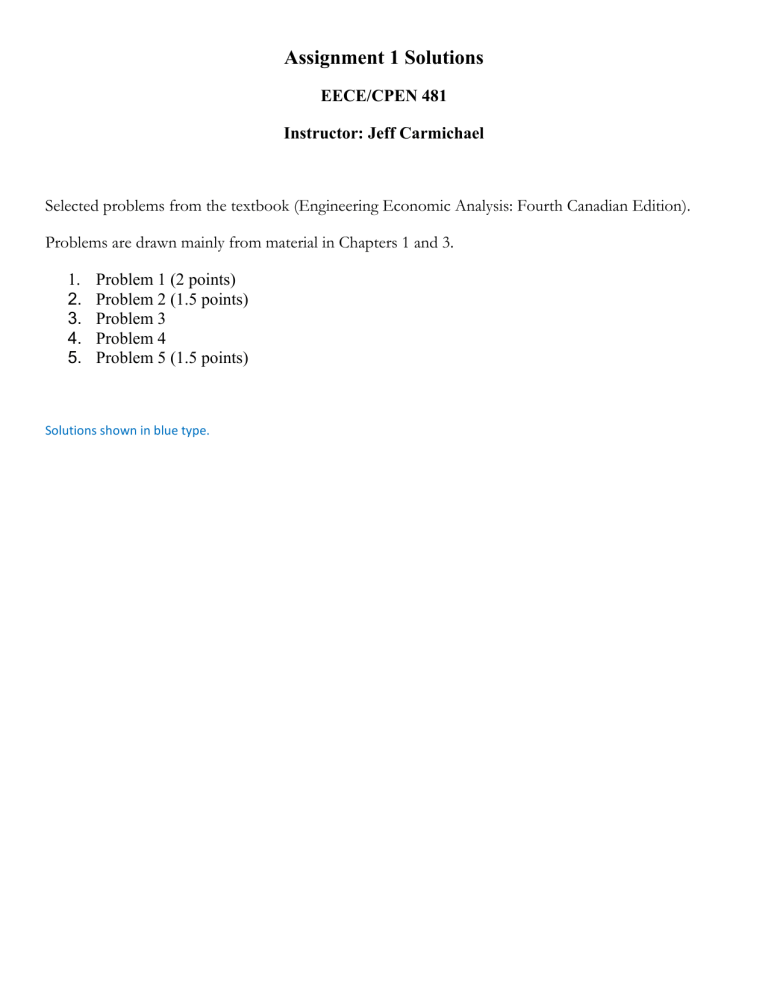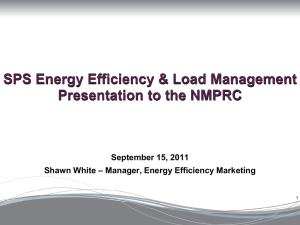
Assignment 1 Solutions EECE/CPEN 481 Instructor: Jeff Carmichael Selected problems from the textbook (Engineering Economic Analysis: Fourth Canadian Edition). Problems are drawn mainly from material in Chapters 1 and 3. 1. 2. 3. 4. 5. Problem 1 (2 points) Problem 2 (1.5 points) Problem 3 Problem 4 Problem 5 (1.5 points) Solutions shown in blue type. 1. Problem 1 A pump has failed in a facility that will be completely replaced in three years. One option would be to buy a new brass pump; it would cost $6,000 (including installation cost), and would last three years. However, a used stainlesssteel pump that should last three more years has been sitting in the maintenance shop for a year. The used pump cost $13,000 when it was new. The accountants say the pump is now worth $7,000. The maintenance supervisor says that it would cost $1,800 to reconfigure the pump for the new use. He also says he could instead sell it used (as is) for $3,500. (a) What is the net benefit or net cost of installing the stainless-steel pump? Of installing the brass pump? (b) Which option is better? (c) What is the opportunity cost for this set of options? (d) How much cheaper or more expensive would it be to use the stainless-steel pump rather than a new brass pump? Solution: (a) Stainless steel pump: Net cost of $1,800. Brass pump: Net cost of $6,000 - $3,500 = $2,500. (b) Stainless steel pump is better (cheaper). (c) -$2,500 (=-$6000 + $3,500). Opportunity cost = net cost of the second best alternative. It includes the cost of the brass pump and the revenue from selling the stainless steel pump. (d) Difference in net cost = (brass: -$6000 + 3500 = -2,500) vs (steel: –1,800) = difference of $700. 2. Problem 2 A small machine shop purchases electricity under the following rates: Usage charges: First 200 kWh at 14 cents per kWh Next 300 kWh at 10 cents per kWh Any additional kWh at 9 cents per kWh Demand charges: First 25 kW without cost Next 75 kW at $ 3 per kW Any additional kW at $5 per kW The shop uses 3,800 kWh per month, and has a peak usage of 150 kW. a) b) c) d) Calculate the total monthly bill, including usage and demand charges, for this shop. What are the average and marginal usage charge costs per kilowatt hour? (Ignore demand charges.) What will the blended rate per kilowatt hour be (including demand charges)? If the shop uses 1,500 kWh more energy each month, but doesn’t increase its peak usage, how much will the monthly bill increase? Which marginal usage charge applies? e) If the shop adds additional machinery that will be used only occasionally each month, it will increase peak usage by an additional 50 kW and will increase energy usage by 400 kWh each month. How much will the monthly bill increase? Solution: (a) Usage charge: Demand charge: Total $ 355 $ 475 $ 830 (b) average user cost: marginal user cost: 9.34 cents per kWh 9 cents per kWh (c) blended rate: 21.84 (d) Additional usage charge: Marginal usage charge: $ 135 9 cents per kWh (e) Additional usage charge: Additional demand charge: Total increase: $ 36 $ 250 $ 286 cents per kWh 3. Problem 3 In your own words explain the time value of money. From your own life (either now or in a situation that might occur in the future), give two examples of how the time value of money would be important. Solution: Time Value of Money means simply that “money has value over time”, meaning that money isn’t always worth the same to us, no matter when we get it. Money has value, of course, because of what it can purchase. However, the time value of money means that ownership of money is valuable, and it is valuable because of the interest dollars that can be earned/gained due to its ownership. Understanding interest and its impact is important in many life circumstances. Examples could include some of the following: • Selecting the best loans for homes, boats, jewelry, automobiles, etc. • Many aspects involved with businesses ownership (payroll, taxes, etc.) • Using the best strategies for paying off personal loans, credit cards, debt • Making investments for life goals (purchases, retirement, college, weddings, etc.). Time value of money is NOT the same as inflation, although it is related. Inflation causes us to want to spend money now instead of in the future, because the item will cost more later on. 4. Problem 4 A bank pays 10% nominal annual interest on special three-year certificates. What is the effective annual interest rate, rounded to two decimal places, if interest is compounded: (a) Every three months? (b) Daily? (c) Continuously? Solution: (a) Effective Interest Rate = (1 + i)m − 1 = (1+10%/4)4-1 = (1.025)4 − 1 = 0.1038 = 10.38% (b) Effective Interest Rate = (1 + i)m − 1 = (1 + (0.10/365))365 − 1 = 0.10516= 10.52% (c) Effective Interest Rate = er − 1 = e0.10 − 1 = 0.10517 = 10.52% 5. Problem 5 In 1995, an anonymous private collector bought a painting by Picasso entitled Angel Fernandez de Soto for $29,000,000. The picture depicts Picasso’s friend de Soto seated in a Barcelona café drinking absinthe. The painting was completed in 1903 and valued then at $600. If the painting was owned by the same family until its sale in 1995, what annual rate of return did they receive on the $600 investment? Round your answer to one decimal place (x.x%). Solution: P = $600 F = $29,000,000 n = 92 years F = P (1 + i)n $29,000,000/$600 = (1 + i)92 = $48,333 (1 + i) = ($48,333)(1/92) i* = 0.124 = 12.4%



